The term “orange mushroom” is a general description of mushrooms that have an orange color in their fruiting bodies, that is, their caps, stems and gills. However, this color can be pale yellow-orange to deep, vibrant orange and sometimes even reddish-orange or brownish-orange hues.
Orange mushrooms belong to different fungal genera, including Amanita, Hygrocybe, Lactarius, Ramaria, Sparassis, and many more. Each genus may have its unique characteristics like spore color, habitat preferences and growth forms.
Orange mushrooms can be found in habitats like forests, grasslands and woodlands. Some species are associated with certain types of trees, while others are more generalist and can be found growing anywhere in the environment like garden, lawn, backyard, farm or roadside.
In many cultures, orange mushrooms are used in culinary applications. When cooked, they can be grilled on skewers, stuffed with crab, cheese, or other meats as a bite-sized appetizer, added into sauces, gravies, stir-fries, soups, stews, baked into tarts, or sliced as a topping on pizza. They can also be cooked with artichokes, chopped into ceviche, or baked into mushroom bread.
Orange mushrooms pair well with tomatoes, carrots, celery, potatoes, jalapenos, garlic, shallots, onion, ginger, fennel, kimchi, lime, sage, parsley, basil, meats such as beef, pork, or poultry, eggs, soy sauce, balsamic vinegar, marinara sauce, cream sauce, white wine, rice, orzo, mozzarella, parmesan and pecorino romano cheese.
Some cultures believe that certain orange mushrooms possess spiritual or medicinal properties. They may be used in traditional healing practices or rituals to treat specific ailments or promote well-being. In such cases, orange mushrooms are considered more than just food; they are seen as a source of healing and spirituality.
Proper identification is essential when dealing with wild mushrooms, especially when it comes to edibility. Mistaking a toxic mushroom for an edible one can have severe consequences. It’s recommended to learn from experienced foragers or mycologists and use field guides or scientific approved methods for identification.
This article is only a general guide to identifying varieties or types of orange mushrooms common. However, its purpose is not to advise on how to identify edible orange mushrooms from poisonous mushrooms.
Why Mushrooms Grow in the Yard
Mushrooms are fungi, and they can grow in yards for several reasons. Mushroom spores are present everywhere in the environment, including the air and soil. If the right combination of environmental conditions occurs, these spores can germinate and grow into mushrooms.
Mushrooms thrive in damp environments. If your yard has a lot of moisture due to rain, irrigation, or poor drainage, it creates a favorable environment for mushroom growth.
Mushrooms are decomposers, and they feed on organic matter such as dead tree roots, decaying leaves, mulch, and other organic debris in the soil. If your yard has a lot of organic material, it can provide a food source for mushroom mycelium.
Many mushroom species prefer shady or partially shaded areas. If your yard has sections with limited sunlight, it can create an environment conducive to mushroom growth.
The composition of your yard’s soil can also influence mushroom growth. Some mushrooms prefer acidic soils, while others thrive in more alkaline conditions. Soil pH, nutrient levels, and texture can impact which mushroom species can grow.
The presence of certain microorganisms, such as mycorrhizal fungi, in the soil can influence mushroom growth. Mycorrhizal fungi form mutually beneficial relationships with the roots of many plants, and they can produce mushrooms as part of their life cycle.
Wind, animals, and human activity can transport mushroom spores to your yard from other areas. These spores can then establish themselves and grow under suitable conditions.
List of Orange Mushrooms
- Amanita caesarea – Caesar’s Mushroom
- Hygrocybe miniata – Vermilion Waxcap
- Hygrocybe punicea – Scarlet Waxcap
- Laccaria laccata – The Deceiver
- Lactarius deliciosus – Saffron Milkcap
- Lactarius hygrophoroides – Hygrophorus Milkcap
- Ramaria botrytis – Clustered Coral
- Hypomyces lactifluorum -lobster mushroom
- Flammulina velutipes – Velvet foot or wild enoki
- Laetiporus sulphureus – Chicken of the Woods
- Aleuria aurantia- Orange Peel Fungus
- Cantharellus cinnabarinus, the red chanterelle
- Hygrocybe reidii – the honey waxcap
Types of Orange Mushrooms With Pictures (Description And Facts)
Amanita caesarea – Caesar’s Mushroom
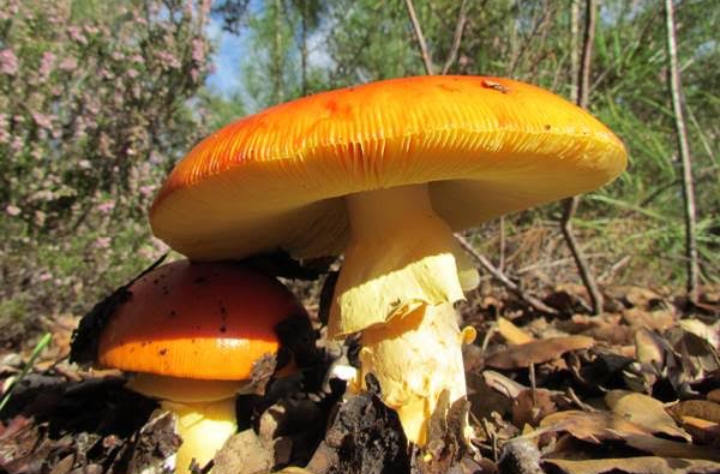
Caesar’s Mushroom has a bright orange to red-orange cap that ranges from 8 to 20 centimeters (3 to 8 inches) in diameter. The cap surface is smooth and slightly sticky when young. As the mushroom matures, the cap expands and flattens, and the color may fade or develop yellowish patches.
The gills are pale-yellow and free from the stem, meaning they do not attach directly to it. The stem is also pale yellow with a skirt-like ring or annulus that is bright orange to match the cap. The base of the stem is bulbous and may be encased in a sack-like volva. The spore print of this Mushroom is white.
Facts And How To Identify
| Scientific Name | Amanita caesarea |
| Family | Amanitaceae |
| Description | While it was first described by Giovanni Antonio Scopoli in 1772 |
| Cap | bright orange to red-orange |
| Gills | Free |
| Stem | Pale yellow and bulbous |
| Spore Print | white |
| Distribution | Europe, North America, Africa and the Middle East. |
| Habitat | It is found in association with oak (Quercus spp.) and pine (Pinus spp.) trees. |
| Edibility | Edible |
Hygrocybe miniata – Vermilion Waxcap
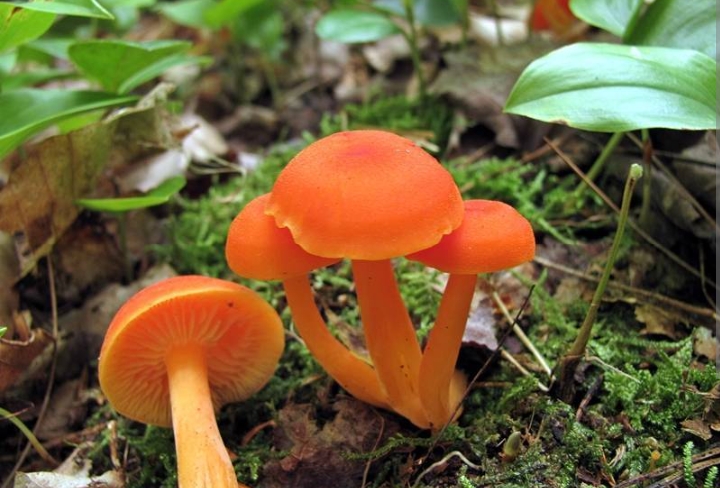
Also referred to as Vermilion waxcap or miniature waxy cap is commonly found in parts of North America, Europe, and other temperate regions. The cap of this mushroom is bright red, orange, or vermilion in color and about 2 to 6 centimeters (0.8 to 2.4 inches) in diameter. The cap is convex when young but may become flatter or even concave as it matures.
The gills are orange and may have a decurrent attachment, meaning they run down the stem slightly. They are moderately spaced and can be somewhat brittle or notched. The flesh is orange, and is devoid of any odor. The spore print is white.
The stem is the same color as the cap or slightly paler. It is cylindrical, slender, and can be up to 8-10 centimeters (3-4 inches) tall. There is no distinctive ring or volva on the stem.
In Australia, it can be found in temperate to subtropical rainforest and eucalypt forest as well as heathland. Fruiting bodies may appear in groups among the leaf litter from January to June.
Facts And How To Identify
| Scientific Name | Hygrocybe miniata |
| Family | Hygrophoraceae |
| Description | First described by Swedish mycologist Elias Magnus Fries as Agaricus miniatus in 1821, before being renamed by the same author in 1838 as Hygrophorus miniatus. |
| Cap | Orange-red, orange or vermilion in color |
| Gills | Have a slightly decurrent attachment |
| Stem | Same color as the cap or slightly paler. No ring or volva. |
| Spore Print | white |
| Distribution | Europe, North America, Africa and Australia |
| Habitat | Often grow in grassy or mossy areas |
| Edibility | Though its edibility is unclear, it is considered nonpoisonous |
Laccaria laccata – The Deceiver or waxy laccaria
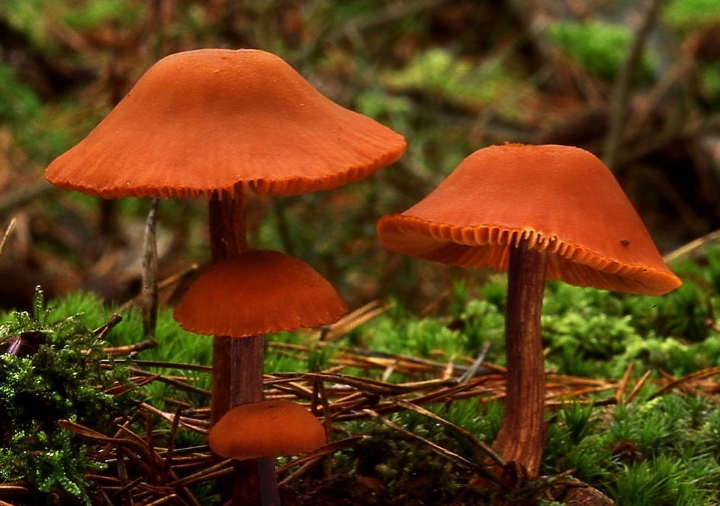
Laccaria laccata, commonly known as the deceiver, lackluster laccaria, or waxy laccaria, is a white-spored species of small to medium size edible mushroom found throughout North America and Europe. The species is often considered by mushroom collectors to be a ‘mushroom weed’ because of its abundance and plain stature.
The cap is about 1 to 6 cm in diameter. It is convex when young, flattening with age. The cap color can be orange, reddish-brown, pink, or even pale gray. The cap surface is usually smooth and sticky when moist.
The irregular gills are widely spaced and decurrent or adnexed, and of similar color to the cap, though whiten with spores as the mushroom matures. The spore print is white. The flesh is thin and has little taste.
The stem is cylindrical, somewhat swollen at the base, and similar in color to the cap. It can range from 3 to 10 cm in height.
Facts And How To Identify
| Scientific Name | Laccaria laccata |
| Family | Hydnangiaceae |
| Description | The deceiver was first described by Tyrolian naturalist Giovanni Antonio Scopoli in 1772 as Agaricus laccatus, before being given its current binomial name by Mordecai Cubitt Cooke in 1884. |
| Cap | Orange, reddish-brown, pink, or even pale gray. |
| Gills | Widely spaced and decurrent or adnexed |
| Stem | Swollen at the base, and similar in color to the cap. |
| Spore Print | White |
| Distribution | Found throughout North America, Asia and Europe. |
| Seasonality | Fruits in late summer to autumn, depending on the local climate. |
| Edibility | Considered edible, but it is not highly sought after for culinary purposes |
Lactarius deliciosus – Saffron Milkcap
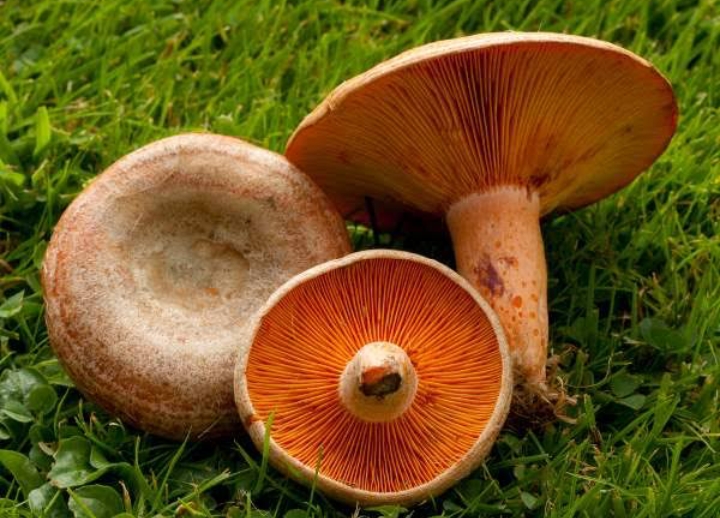
Lactarius deliciosus, commonly known as the delicious milk cap, saffron milk cap and red pine mushroom, is a widely distributed mushroom species. It is native to Europe, but has been accidentally introduced to other countries along with pine trees, with which the fungus is symbiotic.
The cap is small in size, about 1 to 6 cm in diameter. It is convex when young, flattening with age. The cap color can be orange, reddish-brown, pink, or even pale gray. The cap surface is usually smooth but sticky and viscid when wet, but is often dry. It has crowded decurrent gills and a squat orange stipe that is often hollow.
The flesh stains a deep green color when handled. When fresh, it exudes an orange-red latex that does not change color. The stem is cylindrical, usually somewhat swollen at the base, and similar in color to the cap. It can range from 3 to 10 cm in height. The spore print is white.
Facts And How To Identify
| Scientific Name | Lactarius deliciosus |
| Family | Russulaceae |
| Description | Was first described by Carl Linnaeus, in the second volume of his Species Plantarum in 1753, giving it the name Agaricus deliciosus. |
| Cap | orange, reddish-brown, pink, or even pale gray. |
| Gills | moderately spaced and decurrent |
| Stem | 2 to 5 centimeters in height |
| Spore Print | White |
| Distribution | Europe |
| Seasonality | Fruits in late summer to autumn, depending on the local climate. |
| Edibility | Considered edible but may taste mild or bitter |
Lactarius hygrophoroides – Hygrophorus Milkcap
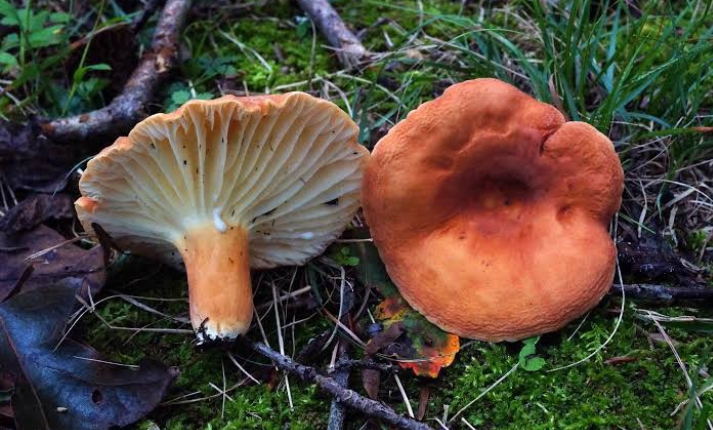
The cap of this mushroom is convex to flattened with a central depression and can reach a diameter of 4-12 cm (1.5-4.7 inches). It is usually sticky when moist and has a pale to brown orange color. The gills underneath the cap are crowded and decurrent (run down the stem). They are often forked and have a white to creamy color that may develop orange tints with age.
The stem has shades of white and orange with a tapered shape. It may have a faint brownish flush towards the base. It lacks a ring or collar.
Like other Lactarius species, L. hygrophoroides produces a milky latex when the gills are damaged. The latex is white and often acrid or peppery in taste. The spore print is white.
They are often found growing on the ground near or under trees, especially oak and pine trees, in moist woodland environments. This mushroom is found in North America, particularly in eastern and central regions of the United States and Canada.
Facts And How To Identify
| Scientific Name | Lactifluus hygrophoroides |
| Family | Russulaceae |
| History | It was first described scientifically by Miles Joseph Berkeley and Moses Ashley Curtis in 1859 as a species of Lactarius, and was historically known by this name until the systematics of milk-cap species were recently revised. |
| Cap | pale to brown orange color |
| Gills | crowded and decurrent |
| Stem | White and orange with a tapered shape |
| Spore Print | White |
| Distribution | North America |
| Seasonality | Fruits in late summer to autumn |
| Edibility | Considered edible by some |
Ramaria botrytis – Clustered Coral
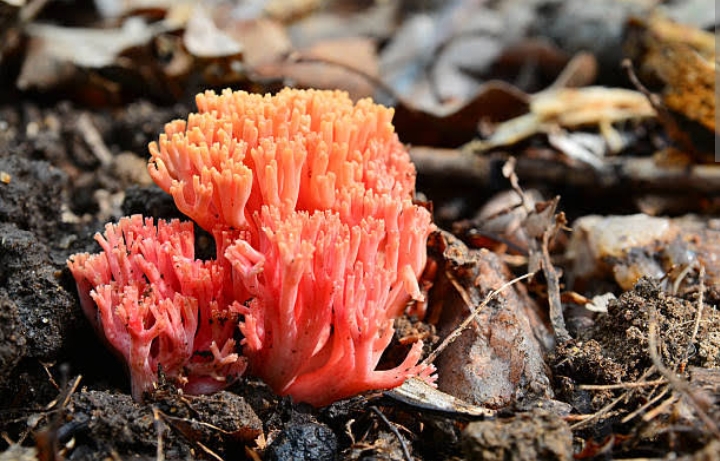
Ramaria botrytis, commonly known as Clustered Coral or Clustered Coral Mushroom is found in parts of North America, Europe, Africa and Asia. It is most commonly associated with coniferous and mixed forests. It tends to grow on the forest floor in clusters or groups.
The fruiting body of Ramaria botrytis consists of numerous branched and elongated coral-like structures that radiate from a common base. These branches can be shades of pink, orange or brown. The tips of the branches are usually paler in color.
Its robust fruit body can grow up to a height of 10-30 centimeters (4-12 inches) with a width of 10-20 centimeters (4-8 inches). It has a central stem or stipe, which is short and thick. It is also covered in a course, net-like pattern and matches the color of the branches. Overall, it resembles a marine coral.
The flesh is thick and white. The spore print is yellowish in color. While Ramaria botrytis is not considered poisonous, though it can be easily confused with other, potentially toxic coral-like mushrooms
Facts And How To Identify
| Scientific Name | Ramaria botrytis |
| Family | Gomphaceae |
| Other Names | the pink-tipped coral mushroom, or the cauliflower coral |
| History | R. botrytis was first described scientifically in 1797 by mycologist Christiaan Hendrik Persoon. |
| Fruiting Body | pink, orange or brown. |
| Stipe/stem | central stem or stipe, which is usually short and thick. |
| Habitat | coniferous and mixed forests. |
| Spore Print | Yellow |
| Distribution | North America, Europe, Asia and Africa |
| Seasonality | Fruits in late summer to autumn |
| Edibility | Considered edible by some |
Hypomyces lactifluorum – lobster mushroom
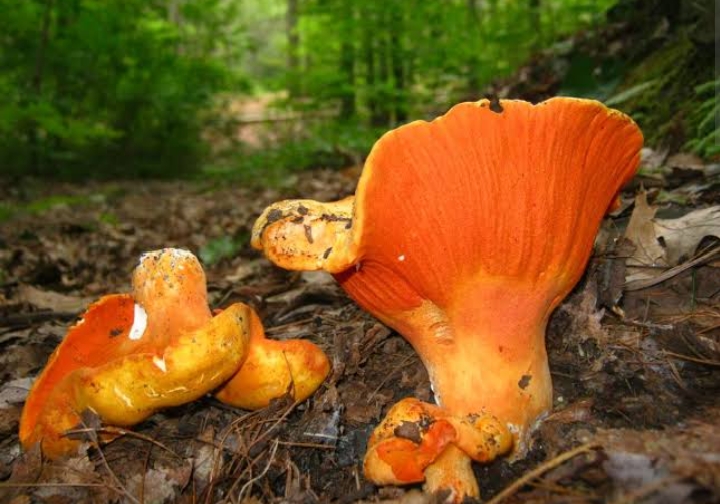
Lobster mushrooms contrary to its common name, is neither a mushroom nor a crustacean, but rather a parasitic ascomycete fungus that grows on other mushrooms. The parasite forms an orange crust that covers and distorts the original mushroom.
In other words, it parasitizes species of mushrooms like those from the Russula and Lactarius genera. As the host mushroom becomes infected, it loses its original features and takes on the lobster mushroom’s appearance.
Lobster mushrooms are gnarled, contorted fungi, averaging 15-20 centimeters in diameter, and have an irregular shape with little to no stem and a cracked cap.
The outer surface of the lobster mushroom becomes bright red to orange, with a texture that resembles a cooked lobster or shrimp shell. When sliced, the flesh is white to pale cream, dense, and spongy with a faint, seafood-like aroma.
Lobster mushrooms are found in parts of the world like North America, Europe, and Asia. They are commonly encountered in temperate forests, especially in coniferous and mixed woodlands.
Lobster mushrooms are generally available in the fall through early winter. In specific regions of North America, they can also be found as early as mid-summer. These mushrooms are widely eaten and enjoyed freshly foraged and cooked. They are commercially marketed and sometimes found in grocery store.
Facts And How To Identify
| Scientific Name | Hypomyces lactifluorum |
| Family | Lactifluus |
| Type | Ascomycete fungus |
| Description | Lobster mushrooms are a unique hybrid between a parasitic fungus and its host mushroom |
| Cap | bright to pale orange |
| Interior Flesh | White to pale cream. |
| Cap Size | 2 to 5 inches (5 to 12 centimeters). |
| Spore Print | White, cream |
| Distribution | North America, Europe, and Asia. |
| Seasonality | fall through early winter |
| Edibility | Edible |
Flammulina velutipes – Velvet foot or wild enoki
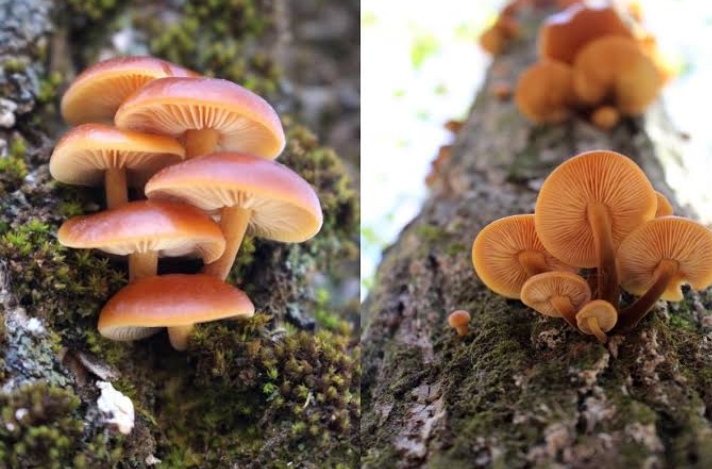
Commonly known as the velvet foot, wild enoki, velvet stem, or velvet shank. The species occurs in Europe, Asia, Africa, Australia and North America. This species is fond of cold weather and usually appears in late fall or winter.
This species is saprophytic and thrives on decaying organic matter, such as dead wood, logs, or tree stumps. In western North America the mushroom commonly grows from the wood of quaking aspen, narrowleaf cottonwood, and other poplars.
The caps are convex when young but can flatten with age. They range in color pale to brown orange. The stem, also known as the “velvet foot,” is cylindrical, lighter in color than the cap, and has a velvety or fibrillose texture. The stem is tough, and some people only prefer to only cook the cap.
The gills on the underside of the cap are close, attached, and white to creamy in color. The mushroom produces a white spore print.
Flammulina velutipes is widely regarded as an edible mushroom and is commonly used in Asian cuisine. In Japanese cuisine, they are known as “enoki” mushrooms and are often used in soups, salads, and hot pots (nabe). They are also popular in Chinese and Korean cuisine, where they are used in stir-fries, dumplings, and other dishes.
Facts And How To Identify
| Scientific Name | Flammulina velutipes |
| Family | Physalacriaceae |
| Classification | The species was originally described from England by botanist William Curtis in 1782 as Agaricus velutipes. It was transferred to the genus Flammulina by Rolf Singer in 1951. |
| Cap | Pale to brown orange |
| Gills | White to creamy in color |
| Stem | lighter in color than the cap |
| Spore Print | white |
| Distribution | Europe, North America, Africa and Australia |
| Habitat | Decaying organic matter, such as dead wood, logs, or tree stumps. |
| Edibility | Edible. Quite common in Japanese cuisine. |
Aleuria aurantia- Orange Peel Fungus
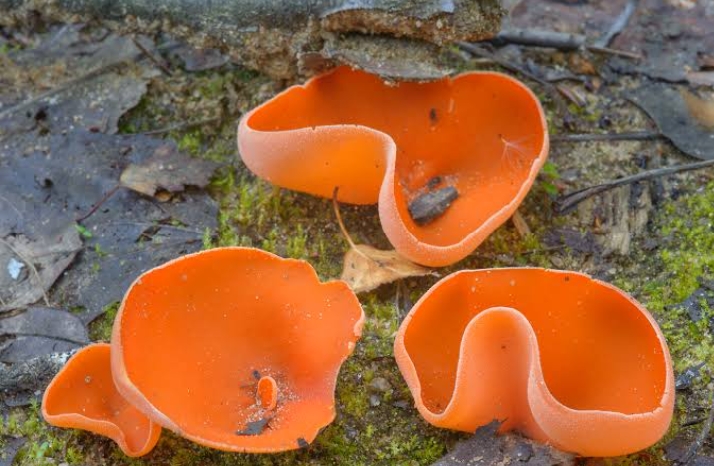
Orange Peel Fungus has a cup-shaped or saucer-like fruiting body, which can measure from 2 to 7 centimeters in diameter. It appears as a vibrant orange or apricot-colored cup with a wrinkled or undulating margin, resembling a discarded orange peel. The inner surface is paler in color.
The surface of the fruiting body is smooth or slightly wrinkled, resembling the texture of a citrus peel. Unlike some other fungi, Aleuria aurantia does not have traditional gills on the underside of its cap. Instead, it has spore-bearing asci lining the inner surface of the cup.
The spores are produced within sac-like structures called asci. These asci contain ascospores, which are released when the fruiting body is disturbed or mature.
Aleuria aurantia is a saprophytic fungus. It is commonly found growing on the ground. It is often associated with decaying plant material such as leaf litter, woody debris or buried wood.
This species has a widespread distribution. It can be found in regions around the world like North America, Europe and Asia. It appears during the late summer and autumn months.
While Aleuria aurantia is not considered toxic, it is generally not consumed as a food source due to its unpalatable texture and taste. The fruiting bodies are tough and rubbery. In Europe, the orange peel may be confused with species of Otidea or Caloscypha which are poisonous or of unknown edibility.
Facts And How To Identify
| Scientific Name | Aleuria aurantia |
| Family | Pyronemataceae |
| Description | The orange peel, Peziza aurantia was first described in 1800 by Christiaan Hendrik Persoon |
| Cap | Orange or apricot-colored |
| Gills | No Gills |
| Stem | No Stem |
| Spore Print | White |
| Distribution | North America, Africa Europe and Asia |
| Seasonality | Fall through early winter |
| Edibility | Not Toxic, Not Edible |
Cantharellus cinnabarinus, the red chanterelle
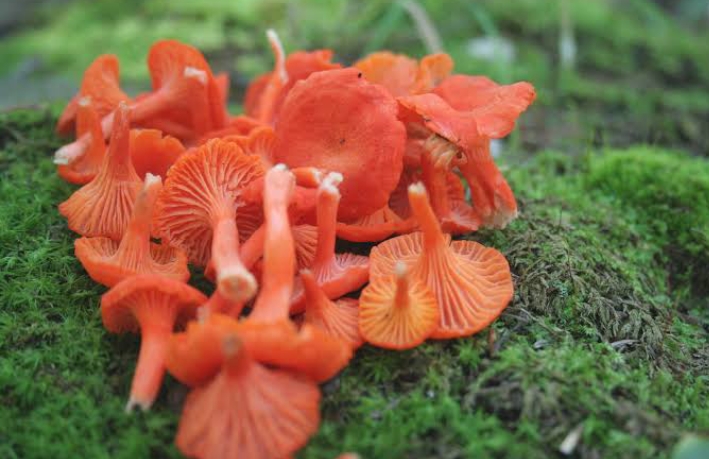
Cantharellus cinnabarinus, commonly known as the Red Chanterelle or the Cinnabar Chanterelle is widely distributed in Eastern and central Northern America. It is found mostly on the ground in broadleaf and mixed broadleaf/conifer forests; usually scattered or occurring in small groups. It is also common in other parts of the world.
The cap of Cantharellus cinnabarinus is funnel-shaped or vase-shaped and measures from 2 to 5 centimeters in diameter. The cap surface is smooth and reddish-orange to cinnabar color. As the mushroom matures, the cap margin becomes wavy or lobed.
Unlike typical chanterelles, which have ridges instead of true gills, Cantharellus cinnabarinus has forked gills that descend the stem. These gills are a paler color than the cap and are often described as “tongue-like.”
The stem of the Red Chanterelle is cylindrical, swollen at the base and can be a similar color to the cap. It is 2 to 5 centimeters long and 0.5 to 1 centimeter in diameter. The flesh is thin and brittle, with a mild earthly aroma. It is pale and may have a faint reddish tinge near the cap.
Red Chanterelles are mycorrhizal fungi. They are commonly associated with hardwood trees, such as oak, beech, and birch. They are most commonly observed during the late summer and fall (from July to November).
Facts And How To Identify
| Scientific Name | Cantharellus cinnabarinus |
| Family | Cantharellaceae |
| Description | Was first described scientifically in 1797 by mycologist Christiaan Hendrik Persoon. |
| Cap | reddish-orange to cinnabar color |
| Gills | Forked Gills |
| Stem | swollen at the base and can be a similar color to the cap |
| Spore Print | White |
| Distribution | Eastern and central North America |
| Seasonality | late summer and fall |
| Edibility | Edible |
Hygrocybe reidii – the honey waxcap
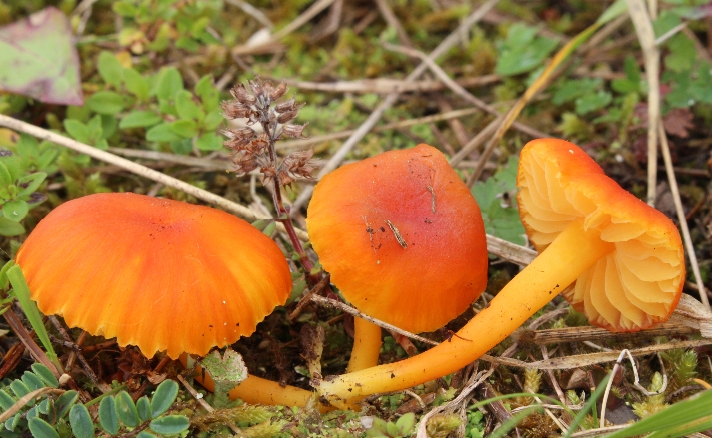
Hygrocybe reidii, commonly known as the honey waxcap has a cap that is convex to broadly convex, with a diameter ranging from 2 to 6 cm. The cap’s color can be from yellow to orange, and has a somewhat viscid or greasy appearance.
The gills are crowded, waxy and decurrent. They are usually a lighter color than the cap. They can be pale yellow to white. The stem is cylindrical, tapering towards the base. It shares the same color as the cap or may be somewhat paler. The spore print is white.
Hygrocybe reidii is a saprophytic mushroom, found mostly on decomposing organic matter such as leaf litter, deadwood and other forest debris. It loves grassy areas, meadows and open woodlands. It prefers well-drained, acidic soils. It appears in the autumn months, usually from September to November.
The honey waxcap is native to Europe and is found in countries across the continent. It is especially common in the British Isles. While primarily European, it has also been documented in parts of North America, although it is considered relatively rare there.
Identifying H. reidii can be challenging, as it closely resembles other waxcap mushrooms in the Hygrocybe genus like Hygrocybe coccinea (scarlet waxcap), Hygrocybe punicea (crimson waxcap), and Hygrocybe chlorophana (golden waxcap).
Although H. reidii is not generally considered toxic, it is not commonly consumed. Some people find it less appealing for culinary purposes compared to other edible mushrooms.
Facts And How To Identify
| Scientific Name | Hygrocybe reidii |
| Family | Hygrophoraceae |
| History | It was published by Robert Kühner in 1976, with the specific epithet honouring British mycologist Derek Reid |
| Cap | Crowded, waxy and decurrent |
| Gills | Orange-yellow to bright orange |
| Stem | Cylindrical and Orange-yellow |
| Spore Print | White |
| Distribution | Europe and North America |
| Seasonality | Autumn |
| Edibility | Not toxic, but not appealing for consumption. |
Guepinia helvelloides- Apricot jelly
Guepinia helvelloides, commonly known as the Apricot Jelly fungus, is primarily found in deciduous and coniferous forests, often growing on rotting wood or decaying plant matter. It is a saprophytic fungus.
Its fruiting body resembles a crumpled or lobed apricot in appearance. The fruiting body is orange or apricot-colored, although the shade can vary from pale orange to deep apricot. The fruiting body also has a gelatinous or jelly-like texture and somewhat translucent appearance.
The underside of the fruiting body has a lighter color than the top, and it may have a somewhat wrinkled or veined appearance. It has a white spore deposit.
This mushroom is not toxic and can be consumed by humans but its gelatinous texture and somewhat insipid taste make it less appealing as a culinary choice compared to other edible mushrooms.
The fungus is widely distributed in the Northern Hemisphere, and has also been collected from South America.
Facts And How To Identify
| Scientific Name | Guepinia helvelloides |
| Family | Dacrymycetaceae |
| History | The species was first described and illustrated as Tremella rufa by Nicolaus Joseph von Jacquin in 1778 |
| Fruiting Body | Orange or apricot-colored |
| Size | Approximately 2 to 5 centimeters (about 0.8 to 2 inches) in diameter |
| Texture | Rubbery, gelatinous or jelly-like texture |
| Spore Print | White |
| Distribution | Europe, South America, North America |
| Seasonality | Fall |
| Edibility | Not toxic, but not appealing for consumption. |
Laccaria proxima – Earthy laccaria
This species is widely distributed in temperate and boreal forests across North America, Africa, Europe, and Asia. It is a saprophytic fungus.
The cap is 2-6 cm in diameter and is initially convex but may flatten out as it matures. The cap’s color can be orange brown or reddish-brown. It may have a slightly darker center.
The gills underneath the cap are closely spaced and are cream to pale pink in color. The stem is cylindrical, paler than the cap, and may have fine fibers on its surface.
It is commonly found growing in coniferous and hardwood forests, where it associates with various tree species, including pines, oaks, and birches. It can also be found in disturbed habitats like clearings and forest edges.
Laccaria proxima is generally considered edible. It can be cooked and served with vegetarian dishes as a meat substitute and used as a topping for chowders, grain bowls and salads.
Facts And How To Identify
| Scientific Name | Laccaria proxima |
| Family | Hydnangiaceae |
| Commonly Found | California |
| Fruiting Body | Orange Brown |
| Size | 2-6 cm |
| Gills | Closely spaced and cream to pale pink in color. |
| Spore Print | White |
| Distribution | Conifer forest of California, as well as eastern and northern North America. |
| Seasonality | Fall |
| Edibility | Edible |
Tylopilus balloui- Ballou’s bolete
Tylopilus balloui was described and named by American mycologist William Alphonso Murrill in 1909. Its scientific name is a tribute to the American mycologist William Ballou, who was a contemporary of Murrill.
Commonly known as Ballou’s bolete or the Eastern oak bolete has a medium to large-sized cap that can measure between 6 and 20 centimeters (2.5 to 8 inches) in diameter. The cap is convex when young and becomes more flattened or even slightly depressed in the center as it matures.
The cap’s color is variable but can brownish to orange-brown with a suede-like texture. The cap surface is covered with small, fine scales, giving it a somewhat scaly appearance.
The pore surface is usually white when young, turning yellowish with age. When touched or bruised, the pore surface may stain brown or blue.
The stem is cylindrical swollen towards the base, and can measure between 6 and 15 centimeters (2.5 to 6 inches) in length. It is white to pale brown and covered with a network-like pattern or reticulation on the upper portion of the stem.
The flesh of this mushroom is white, turning pale yellow or brown when exposed to air or damaged. It has a mild, nutty odor and a taste that is generally considered pleasant, though it may become slightly bitter with age.
It is found in eastern North America, including the Appalachian region, and it is commonly associated with hardwood forests, particularly oak trees. It grows on the ground near or around oak trees.
Tylopilus balloui is generally considered edible, and some people enjoy eating it. However, like many wild mushrooms, it can be confused with toxic species, especially other boletes.
Facts And How To Identify
| Scientific Name | Tylopilus balloui |
| Family | Boletaceae |
| Cap Color | brownish to orange-brown |
| Flesh | White |
| Stem | white to pale brown |
| Description | Described and named by American mycologist William Alphonso Murrill in 1909. |
| Spore Print | White when young, turning yellowish with age |
| Distribution | North America |
| Seasonality | Autumn |
| Edibility | Edible |
Lactarius porninsis, the larch milkcap
This mushroom species is primarily found in the Northern Hemisphere, particularly in Europe and Asia. It is found in coniferous and mixed forests, particularly in association with larch trees.
This mushroom is medium-sized mushroom with a cap of about 5 to 15 centimeters (2 to 6 inches) in diameter. The cap is convex but flattens out with age. It has a reddish-brown to orange-brown color with concentric zones or rings on the cap surface.
The cap’s flesh exudes a milky latex when cut or damaged, which is a characteristic feature of the Lactarius genus.
The gills are close together, appearing somewhat decurrent. They are white or pale cream in color. The spore print is cream, while the spores are ellipsoid.
This is generally considered edible although Some people find its taste and texture less appealing compared to other edible mushrooms.
Facts And How To Identify
| Scientific Name | Lactarius porninsis |
| Genus | Lactarius |
| Cap Color | Reddish brown to orange-brown |
| Gills | Decurrent |
| Stem | white to pale brown |
| Cap | The cap’s flesh exudes a milky latex when cut or damaged. |
| Spore Print | White |
| Distribution | Europe, Asia, South America and Africa |
| Seasonality | Autumn |
| Edibility | Edible |